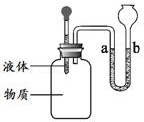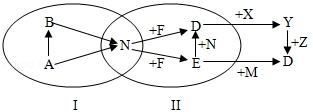下列用字母表示的10种物质是由H、C、O、Ca、Cl、Fe中的几种元素组成,它们是初中化学常见的物质.题中“→”表示物质间存在转化关系,部分反应物、生成物及反应条件已略去。已知圈Ⅰ中的转化均是分解反应,圈Ⅱ中的转化均是化合反应。


(1)Y是大理石的主要成分,则Y的化学式为 。
(2)N和F是常见的非金属单质,化合物A和B的元素种类相同,化合物D和E的元素种类也相同,请写出A→B反应的化学方程式 ,E+N反应的化学方程式 。
(3)从上述物质中任选物质,按下图所示装置进行实验。当胶头滴管中的液体滴入瓶中,U型管中的液面发生了明显变化,请分别写出符合下列实验现象的物质的化学式。
| 现象 序号 | a处水液降低 | b处液面降低 |
| ① | ||
| ② |
(1)CaCO3 (2)2H2O2 2H2O+O2↑;2CO+O2
2H2O+O2↑;2CO+O2 2CO2(3)
2CO2(3)
| 现象 序号 | a处水液降低 | b处液面降低 |
| ① | HCl Fe | CO2 H2O |
| ② | CaCO3 HCl | CO2 Ca(OH)2 |
题目分析:(1)Y是大理石的主要成分,所以Y就是碳酸钙,故答案为:CaCO3;
(2)物质是由H、C、O、Ca、Cl、Fe中的几种元素组成,化合物A和B的元素种类相同,A和B都会转化成非金属单质Y,所以A就是过氧化氢,B就是水,N就是氧气。氧气和F会生成E、D,化合物D和E的元素种类也相同,E和氧气反应会生成D,所以F是碳,E是一氧化碳,D就是二氧化碳,则X就是氢氧化钙,Z是盐酸,M就是金属氧化物,经过验证各物质都满足转换关系。过氧化氢在二氧化锰的催化作用下生成水和氧气,一氧化碳和氧气在点燃的条件下生成二氧化碳,故答案为:2H2O2 2H2O+O2↑,2CO+O2
2H2O+O2↑,2CO+O2 2CO2。
2CO2。
(3)b处液面降低,说明瓶内的压强减小,可以采用气体和液体反应使压强减小,二氧化碳和氢氧化钙,二氧化碳和水都满足要求。a处液面降低,说明瓶内的压强增大,可以采用固体和酸反应生成气体的方法是气压增大,碳酸钙和盐酸反应,铁和盐酸反应。
